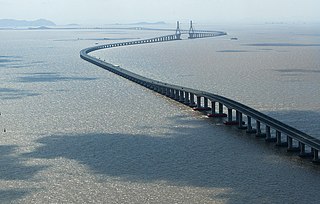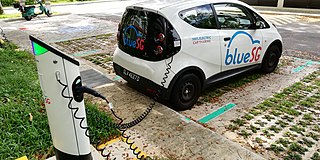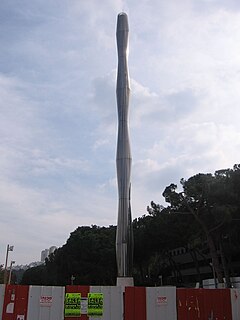
The World Intellectual Property Organization is one of the 15 specialized agencies of the United Nations (UN). Pursuant to the 1967 Convention Establishing the World Intellectual Property Organization, WIPO was created to promote and protect intellectual property (IP) across the world by cooperating with countries as well as international organizations. It began operations on 26 April 1970 when the convention entered into force. The current Director General is Singaporean Daren Tang, former head of the Intellectual Property Office of Singapore, who began his term on 1 October 2020.

Science and technology in China have developed rapidly during the 1990s to 2010s. The Chinese government has placed emphasis through funding, reform, and societal status on science and technology as a fundamental part of the socio-economic development of the country as well as for national prestige. China has made rapid advances in areas such as education, infrastructure, high-tech manufacturing, academic publishing, patents, and commercial applications and is now in some areas and by some measures a world leader. China is now increasingly targeting indigenous innovation and aims to reform remaining weaknesses.
Science and technology in Israel is one of the country's most developed sectors. Israel spent 4.3% of its gross domestic product (GDP) on civil research and development in 2015, the highest ratio in the world. In 2019, Israel was ranked the world's fifth most innovative country by the Bloomberg Innovation Index. It ranks thirteenth in the world for scientific output as measured by the number of scientific publications per million citizens. In 2014, Israel's share of scientific articles published worldwide (0.9%) was much higher than its share of the global population (0.1%).

A science park is defined as being a property-based development that accommodates and fosters the growth of tenant firms and that is affiliated with a university based on proximity, ownership, and/or governance. This is so that knowledge can be shared, innovation promoted, and research outcomes progressed to viable commercial products. Science parks are also often perceived as contributing to national economic development, stimulating the formation of new high-technology firms, attracting foreign investment and promoting exports.

The semiconductor industry is the aggregate of companies engaged in the design and fabrication of semiconductors and semiconductor devices, such as transistors and integrated circuits. It formed around 1960, once the fabrication of semiconductor devices became a viable business. The industry's annual semiconductor sales revenue has since grown to over $481 billion, as of 2018. The semiconductor industry is in turn the driving force behind the wider electronics industry, with annual power electronics sales of £135 billion as of 2011, annual consumer electronics sales expected to reach $2.9 trillion by 2020, tech industry sales expected to reach $5 trillion in 2019, and e-commerce with over $29 trillion in 2017.

The Singapore Self-Propelled Howitzer 1 Primus is a self-propelled howitzer armed with a 155 mm howitzer. Developed jointly by the Singapore Armed Forces (SAF), Defence Science and Technology Agency (DSTA) and Singapore Technologies Kinetics, it was officially inducted to the Singapore Artillery in 2004. Primus is derived from the Artillery motto In Oriente Primus.

Environmental technology (envirotech), green technology (greentech) or clean technology (cleantech) is the application of one or more of environmental science, green chemistry, environmental monitoring and electronic devices to monitor, model and conserve the natural environment and resources, and to curb the negative impacts of human involvement. The term is also used to describe sustainable energy generation technologies such as photovoltaics, wind turbines, etc. Sustainable development is the core of environmental technologies. The term environmental technologies is also used to describe a class of electronic devices that can promote sustainable management of resources.

Continental AG, commonly known as Continental or colloquially as Conti, is a German multinational automotive parts manufacturing company specializing in brake systems, interior electronics, automotive safety, powertrain and chassis components, tachographs, tires and other parts for the automotive and transportation industries. Continental is structured into six divisions: Chassis and Safety, Powertrain, Interior, Tires, ContiTech, ADAS. It is headquartered in Hanover, Lower Saxony. Continental is the world's fourth-largest tire manufacturer.

Stanford Robert Ovshinsky was an American engineer, scientist and inventor who over a span of fifty years was granted well over 400 patents, mostly in the areas of energy and information. Many of his inventions have had wide-ranging applications. Among the most prominent are: the nickel-metal hydride battery, which has been widely used in laptop computers, digital cameras, cell phones, and electric and hybrid cars; flexible thin-film solar energy laminates and panels; flat screen liquid crystal displays; rewritable CD and DVD discs; hydrogen fuel cells; and nonvolatile phase-change memory.

Clean technology, in short cleantech, is any process, product, or service that reduces negative environmental impacts through significant energy efficiency improvements, the sustainable use of resources, or environmental protection activities. Clean technology includes a broad range of technology related to recycling, renewable energy, information technology, green transportation, electric motors, green chemistry, lighting, grey water, and more. Environmental finance is a method by which new clean technology projects can obtain financing through the generation of carbon credits. A project that is developed with concern for climate change mitigation is also known as a carbon project.

Science and technology in Japan has helped fuel the rapid economic, industrial and economic development of the country. Japan has a long history and tradition for scientific research and development, stretching as far back as the Meiji period.

Michael Grätzel is a professor at the École Polytechnique Fédérale de Lausanne where he directs the Laboratory of Photonics and Interfaces. He pioneered research on energy and electron transfer reactions in mesoscopic-materials and their optoelectronic applications. He co-invented with Brian O'Regan the Grätzel cell in 1988.
The IEEE Consumer Technology Society (CTSoc), formerly IEEE Consumer Electronics Society (CESoc), is a professional society of the Institute of Electrical and Electronics Engineers (IEEE) that focuses on the "theory and practice of Electronic Engineering and of the allied arts and sciences with respect to the field of Consumer Electronics and the maintenance of a high professional standing among its members". Wahab Almuhtadi is the current president of the IEEE CE society.

Rachid Yazami is a Moroccan scientist, engineer, and inventor. He is best known for his critical role in the development of the graphite anode for lithium-ion batteries and his research on fluoride ion batteries.

Iran has made considerable advances in science and technology through education and training, despite international sanctions in almost all aspects of research during the past 30 years. Iran's university population swelled from 100,000 in 1979 to 2 million in 2006. In recent years, the growth in Iran's scientific output is reported to be the fastest in the world.

T3 Technion Technology Transfer is the technology transfer unit of the Technion – Israel Institute of Technology in Israel. The unit operates under the auspices of the Technion Research & Development Foundation.

Kuzhikalail M. Abraham is an American scientist, a recognized expert on lithium-ion and lithium-ion polymer batteries and is the inventor of the ultrahigh energy density lithium–air battery. Abraham is the principal of E-KEM Sciences in Needham, Massachusetts and a Professor at the Northeastern University Center for Renewable Energy Technologies, Northeastern University, in Boston, Massachusetts.
Science and Technology is one of the main field of the state policy that generally affects all aspects in Azerbaijan. Azerbaijan National Academy of Sciences (ANAS) is considered as the central agency for science and technology in order to implement state policy in this field.
The Strategic Innovation Fund (SIF) is the program of Innovation, Science and Economic Development Canada designed to support the "Canadian innovation ecosystem," which includes providing "funding to innovative sectors" such as "advanced manufacturing, agri-food, clean technology, clean resources, digital industries, and health and biosciences." The SIF covers all sectors of the Canadian economy and is available to both for-profit and not-for profit organizations.














